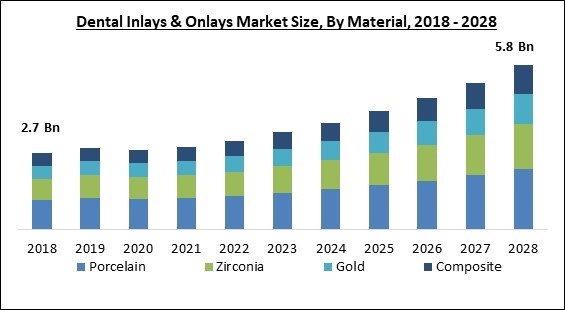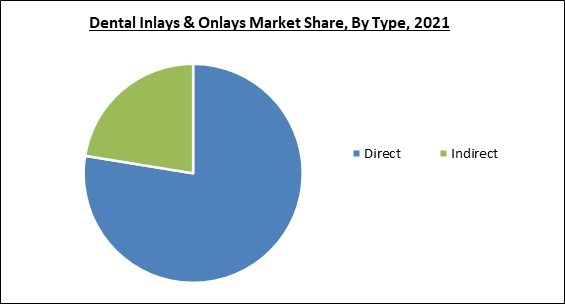An inlay will cover the chewing region between both the cusps and include the fissures and pits of a tooth. An onlay would involve covering one or more cusps. A crown is referred to as such if it completely covers the tooth, including all cusps. When an intracoronal restoration is intended for a tooth, the decay or fracture may be very severe that a direct restoration with amalgam or composite would impair the tooth's structural integrity or would not provide adequate resistance to occlusal forces. An indirect gold and porcelain inlay repair may be suggested in these circumstances.
Gold was traditionally utilized to make inlays and onlays, and it is still often used today. Inlays made of other materials, such as porcelain, were first mentioned in 1857. Porcelain offers a patient more cosmetic value because of its tooth-like color. Inlays and Onlays are now more frequently created using ceramic materials in recent years. The first ceramic inlay produced by a chair-side CAD-CAM system was applied to a patient in 1985. The CEREC 3 was developed more recently, in 2000. This makes it possible to design and fit inlays and onlays in the same appointment. Furthermore, the machine's 3D scanning capabilities eliminate the necessity for obtaining impressions.
COVID-19 Impact Analysis
Businesses throughout the industry were damaged. Moreover, the COVID-19 outbreak also impacted the dental inlay and onlay market. Due to the severe restrictions and lockdown enforced by the government in 2020 in response to the COVID-19 epidemic, market growth has been severely hampered. The outbreak has caused the closure of dental care facilities and a decline in patient appointments to dental clinics. Dental inlays and onlays materials cannot be obtained because raw materials cannot be procured, which has a detrimental effect on the supply chain for these materials.Market Growth Factors
The increasing burden of dental diseases all over the world
In recent years, there is a sharp increase in the number of oral diseases and problems all over the world. A vital sign of general health, happiness, or quality of life is oral health. Dental caries, periodontal disease, oral cancer, tooth loss, oro-dental trauma, noma, and birth deformities, including cleft lip and palate are just a few of the illnesses and ailments that fall under this umbrella term. According to the Global Burden of Disease Study of the World Health Organization, approximately 3.5 billion people are anticipated to be affected by oral disorders. Approximately 180,000 people throughout the world pass away from malignancies of the lip and oral cavity each year. The constantly rising burden of dental issues all over the world is significantly augmenting the growth of the dental inlays and onlays market.Rapidly rising geriatric population all over the world
In the entire world, the percentage of people 65 and older rose from 6% in 1990 to 9% in 2019. By 2050, the percentage is expected to increase to 16%, meaning that 1 in 6 individuals worldwide would be 65 years of age or older. As people in their elderly age are more prone to acquire dental diseases, the demand for dental inlays and onlays is increasing due to a rise in the geriatric population all over the world. Thus, this factor is boosting the growth of the dental inlays and onlays market.Market Restraining Factors
High cost of the deployment of inlays and onlays
One of the biggest factors that are impeding the growth of the dental inlays and onlays market is the high cost of the entire procedure. Dental inlays and onlays vary in price depending on a number of variables, including the material and the dentist's level of training. Onlays for the mouth usually cost the same as inlays. These restorations may cost a little bit more, but they usually take up more space. Porcelain, composite resin, or gold are just a few of the materials that can be used to create inlays and onlays. The most aesthetically pleasing alternative is porcelain, but it is generally the most expensive. This factor is hampering the growth of the market.Material Outlook
Based on Material, the Dental Inlays & Onlays Market is Porcelain, Zirconia, Gold, and Composite. In 2021, the porcelain segment acquired the largest revenue share of the dental inlays and onlays market. The growth of the segment is increasing due to the sudden increase in cosmetic dentistry procedures and the demand for porcelain dental inlays and onlays within dental offices, as well as the widespread use of porcelain materials in dental restoration techniques.Type Outlook
On the basis of Type, the Type, the Dental Inlays & Onlays Market is bifurcated into Direct and Indirect. In 2021, the indirect segment registered a substantial revenue share of the dental inlays and outlays market. Using an imprint of the prepared tooth, an indirect approach includes constructing the restoration outside of the oral cavity. Some of the drawbacks of direct resin composites, like polymerization shrinkage to the breadth of the luting gap, are avoided by this method.Regional Outlook
Region-Wise, the Dental Inlays & Onlays Market is analyzed across North America, Europe, Asia-Pacific, and LAMEA. In 2021, North America accounted for the highest revenue share of the dental inlays and outlays market. This is due to an increase in the number of dental procedures performed in the region, an increase in the frequency of dental illnesses, and a rise in oral health awareness among consumers. Other factors that contribute to the market's expansion in North America include the availability of qualified dental professionals, an increase in dental care spending, the presence of well-developed healthcare infrastructure, a rise in the demand for advanced technological cosmetic dentistry practices, and high personal disposable income.The market research report covers the analysis of key stake holders of the market. Key companies profiled in the report include 3M Company, James R. Glidewell, Dental Ceramics, Inc., Coltene Whaledent, Inc., Den-Mat Holdings, LLC, Dentsply Sirona, Inc., Ivoclar Vivadent AG, Institut Straumann AG, National Dentex Labs, Smile Brands, and Aspen Dental Management, Inc.
Scope of the Study
Market Segments Covered in the Report:
By Type
- Direct
- Indirect
By Material
- Porcelain
- Zirconia
- Gold
- Composite
By Geography
- North America
- US
- Canada
- Mexico
- Rest of North America
- Europe
- Germany
- UK
- France
- Russia
- Spain
- Italy
- Rest of Europe
- Asia Pacific
- China
- Japan
- India
- South Korea
- Singapore
- Malaysia
- Rest of Asia Pacific
- LAMEA
- Brazil
- Argentina
- UAE
- Saudi Arabia
- South Africa
- Nigeria
- Rest of LAMEA
Key Market Players
List of Companies Profiled in the Report:
- 3M Company
- James R. Glidewell, Dental Ceramics, Inc.
- Coltene Whaledent, Inc.
- Den-Mat Holdings, LLC
- Dentsply Sirona, Inc.
- Ivoclar Vivadent AG
- Institut Straumann AG
- National Dentex Labs
- Smile Brands
- Aspen Dental Management, Inc.
Unique Offerings from the Publisher
- Exhaustive coverage
- The highest number of Market tables and figures
- Subscription-based model available
- Guaranteed best price
- Assured post sales research support with 10% customization free
Table of Contents
Companies Mentioned
- 3M Company
- James R. Glidewell, Dental Ceramics, Inc.
- Coltene Whaledent, Inc.
- Den-Mat Holdings, LLC
- Dentsply Sirona, Inc.
- Ivoclar Vivadent AG
- Institut Straumann AG
- National Dentex Labs
- Smile Brands
- Aspen Dental Management, Inc.










